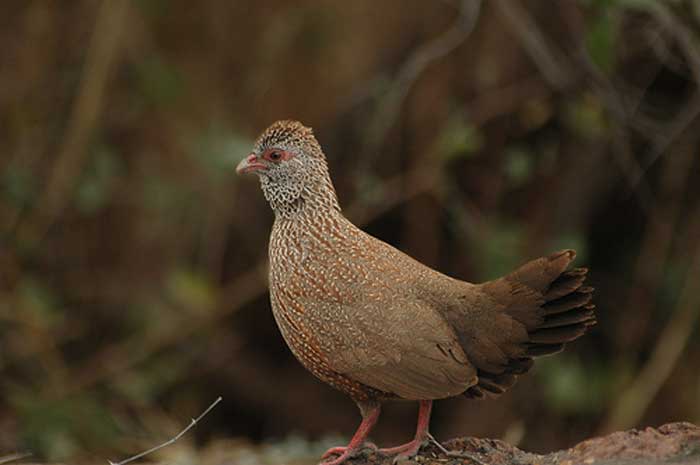
Ptilopachus petrosus (*)
Superregnum: Eukaryota
Cladus: Unikonta
Cladus: Opisthokonta
Cladus: Holozoa
Regnum: Animalia
Subregnum: Eumetazoa
Cladus: Bilateria
Cladus: Nephrozoa
Superphylum: Deuterostomia
Phylum: Chordata
Subphylum: Vertebrata
Infraphylum: Gnathostomata
Megaclassis: Osteichthyes
Cladus: Sarcopterygii
Cladus: Rhipidistia
Cladus: Tetrapodomorpha
Cladus: Eotetrapodiformes
Cladus: Elpistostegalia
Superclassis: Tetrapoda
Cladus: Reptiliomorpha
Cladus: Amniota
Classis: Reptilia
Cladus: Eureptilia
Cladus: Romeriida
Subclassis: Diapsida
Cladus: Sauria
Infraclassis: Archosauromorpha
Cladus: Crurotarsi
Divisio: Archosauria
Cladus: Avemetatarsalia
Cladus: Ornithodira
Subtaxon: Dinosauromorpha
Cladus: Dinosauriformes
Cladus: Dracohors
Cladus: Dinosauria
Ordo: Saurischia
Cladus: Eusaurischia
Subordo: Theropoda
Cladus: Neotheropoda
Cladus: Averostra
Cladus: Tetanurae
Cladus: Avetheropoda
Cladus: Coelurosauria
Cladus: Tyrannoraptora
Cladus: Maniraptoromorpha
Cladus: Maniraptoriformes
Cladus: Maniraptora
Cladus: Pennaraptora
Cladus: Paraves
Cladus: Eumaniraptora
Cladus: Avialae
Infraclassis: Aves
Cladus: Euavialae
Cladus: Avebrevicauda
Cladus: Pygostylia
Cladus: Ornithothoraces
Cladus: Ornithuromorpha
Cladus: Carinatae
Parvclassis: Neornithes
Cohors: Neognathae
Cladus: Pangalloanserae
Cladus: Galloanseres
Ordo: Galliformes
Familia: Phasianidae
Subfamilia: Perdicinae
Genus: Ptilopachus
Species: Ptilopachus petrosus
Subspecies: P. p. brehmi - P. p. florentiae - P. p. major - P. p. petrosus - P. p. saturatior
Name
Ptilopachus petrosus (Gmelin, 1789)
References
Systema Naturae 1 pt2 p. 758
Vernacular names
English: Stone Partridge
svenska: Stenvaktel
The stone partridge (Ptilopachus petrosus) is a bird of the New World quail family. This largely brown bird, which commonly holds its tail raised, is found in scrubland and lightly wooded habitats, often near rocks, from Kenya and Ethiopia to Gambia (a large part if its range is in the Sudanian Savanna).
Taxonomy
The stone partridge was formally described in 1789 by the German naturalist Johann Friedrich Gmelin in his revised and expanded edition of Carl Linnaeus's Systema Naturae. He placed it with all the other partridge like birds in the genus Tetrao and coined the binomial name Tetrao petrosus.[2] Gmelin's description was based on the Comte de Buffon's "Le perdrix de roche ou de la Gambia" and John Latham's "Rufous-breasted partridge".[3][4] The stone partridge is now placed with Nahan's partridge in the genus Ptilopachus that was introduced in 1837 by the English naturalist William John Swainson.[5][6] The genus name is from the Ancient Greek ptilon meaning "feather" with pakhus meaning "thick" or "dense". The specific epithet petrosus is Latin meaning "rocky".[7]
Four subspecies are recognised:[6]
P. p. petrosus (Gmelin, JF, 1789) – Gambia to Cameroon
P. p. brehmi Neumann, 1908 – south Chad to central Sudan
P. p. major Neumann, 1908 – north Ethiopia
P. p. florentiae Ogilvie-Grant, 1900 – south Sudan and south Ethiopia to northeast DR Congo, north Uganda and central Kenya
Some confusion exists in the naming of this species because the name of this bird in many languages translates literally into English as "rock partridge". For instance, in Dutch the species is rotspatrijs, in German - Felsenhenne, in French - poulette de roche - all literal translations of "rock partridge". The bird known as rock partridge in English is actually a member of another genus, Alectoris graeca. The confusion is further compounded as in some languages, Alectoris species are known by names that literally translate as stone partridge. In Dutch, steenpatrijs, in German Steinhuhn; red-legged partridge (A. rufa) being rode steenpatrijs in Dutch. Further complication arises as, particularly within the US, the name "rock partridge" has been used for a variety of Alectoris species and hybrids. The international bird trade, for sport, aviaries' and meat, has led to misapplication of various of these common and scientific names. Alectoris and Ptilopachus species are actually very different in size and habits, Ptilopachus being only 20–25 cm long.
Description
The stone partridge is exceptional among gamebirds in that the female, to human eyes, is showier than the male. Both sexes are predominantly earthy chocolate brown above, with sparse, pale, cream-grey spotting. The head, neck, and chest are paler brown and have broad cream edging to the feathers that gives the bird a scaled appearance. In males, the lower chest and belly are orange-cream; in females, very pale cream. Both sexes raise their crown feathers to form a rudimentary crest, but the feathers of females are somewhat longer, hence more obvious when raised.
Eggs are pale pink, fading to cream; juveniles are dark chocolate-brown throughout, moulting into adult plumage at several weeks old. In captivity at least, the male plays a major role in both incubation and rearing of the young, offering young small items of food by picking them up, dropping them, and calling to the chicks.
Distribution and habitat
Widespread and common throughout its large range, the stone partridge is evaluated as least concern on the IUCN Red List of Threatened Species.
Since 2000, the stone partridge has been imported into the United States and Europe, where it is hoped that it will become established in zoos and bird collections.
Philately
The stone partridge is featured on a 5F stamp of Ivory Coast.
References
BirdLife International (2016). "Ptilopachus petrosus". IUCN Red List of Threatened Species. 2016: e.T22679110A92803123. doi:10.2305/IUCN.UK.2016-3.RLTS.T22679110A92803123.en. Retrieved 13 November 2021.
Gmelin, Johann Friedrich (1789). Systema naturae per regna tria naturae : secundum classes, ordines, genera, species, cum characteribus, differentiis, synonymis, locis (in Latin). Vol. 1, Part 2 (13th ed.). Lipsiae [Leipzig]: Georg. Emanuel. Beer. p. 758.
Buffon, Georges-Louis Leclerc de (1771). "Le perdrix de roche ou de la Gambia". Histoire Naturelle des Oiseaux (in French). Vol. 2. Paris: De l'Imprimerie Royale. p. 446.
Latham, John (1783). A General Synopsis of Birds. Vol. 2, Part 2. London: Printed for Leigh and Sotheby. p. 771, No. 14.
Swainson, William John (1837). On the Natural History and Classification of Birds. Vol. 2. London: Longman, Rees, Orme, Brown, Green & Longman and John Taylor. p. 344.
Gill, Frank; Donsker, David; Rasmussen, Pamela, eds. (January 2022). "Megapodes, guans, guineafowl, New World quail". IOC World Bird List Version 12.1. International Ornithologists' Union. Retrieved 5 July 2022.
Jobling, James A. (2010). The Helm Dictionary of Scientific Bird Names. London: Christopher Helm. pp. 323, 300. ISBN 978-1-4081-2501-4.
External links
BirdLife Species Factsheet
bird-stamps.org
Retrieved from "http://en.wikipedia.org/"
All text is available under the terms of the GNU Free Documentation License

